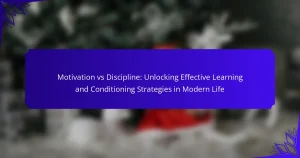Effective learning and conditioning are essential for knowledge retention and behaviour modification. This article explores foundational principles like reinforcement and association, addresses challenges such as information overload and lack of engagement, and presents modern strategies including personalised learning and technology integration. Additionally, it highlights rare techniques like spaced repetition and analogical reasoning, while considering the influence of cultural factors on learning practices.

What are the foundational principles of learning and conditioning?
The foundational principles of learning and conditioning include reinforcement, association, and observation. Reinforcement strengthens behaviour through rewards or punishments. Association links stimuli to responses, while observation emphasises learning through modelling others. These principles inform modern techniques in education and behaviour modification.
How do classical and operant conditioning differ?
Classical conditioning involves learning through association, while operant conditioning relies on reinforcement or punishment to shape behaviour. Classical conditioning pairs stimuli to elicit responses, whereas operant conditioning modifies behaviour based on consequences. Both are foundational concepts in behavioural psychology that inform modern learning strategies.
What role does reinforcement play in learning?
Reinforcement is crucial in learning as it strengthens behaviours through rewards or consequences. Positive reinforcement encourages desired actions by providing rewards, while negative reinforcement removes unfavourable stimuli, enhancing learning effectiveness. This dual approach creates a robust framework for behaviour modification and skill acquisition. Reinforcement schedules, such as fixed or variable intervals, further influence the learning process by impacting retention and motivation. Understanding these dynamics allows for the development of effective educational strategies that align with individual learning needs.
What types of reinforcement are most effective?
Positive reinforcement, negative reinforcement, and punishment are the most effective types of reinforcement in learning and conditioning. Positive reinforcement involves adding a rewarding stimulus to increase desired behaviour. Negative reinforcement entails removing an aversive stimulus to enhance behaviour. Punishment, while less effective for long-term learning, can deter unwanted behaviours. Each type has unique attributes that influence its effectiveness, such as the immediacy of the reinforcement and individual differences in response.
How does punishment affect behaviour modification?
Punishment can lead to temporary behaviour modification but may not result in lasting change. It often creates fear or resentment, which can hinder learning. Effective alternatives include positive reinforcement and consistent feedback to encourage desired behaviours. Research shows that positive strategies yield more sustainable outcomes compared to punitive measures.

What are the universal challenges in modern learning and conditioning?
Modern learning and conditioning face universal challenges such as information overload, lack of engagement, and varying individual learning styles. These issues hinder effective knowledge retention and application.
Information overload occurs when learners are bombarded with excessive data, making it difficult to discern valuable insights. This can lead to cognitive fatigue and decreased motivation.
Lack of engagement is another significant challenge. Traditional learning methods often fail to captivate learners, resulting in diminished interest and participation. Engaging techniques, such as interactive content, can mitigate this issue.
Varying individual learning styles complicate the learning process. Not all learners absorb information in the same way, requiring flexible approaches to accommodate diverse needs. Personalised learning strategies can enhance effectiveness and retention.
How do distractions impact learning outcomes?
Distractions negatively impact learning outcomes by reducing focus and retention. Research shows that multitasking can decrease productivity by up to 40%. This disruption hinders the ability to absorb and process information effectively. Strategies to mitigate distractions include creating a dedicated study environment and utilising time management techniques.
What are the cognitive biases that hinder effective conditioning?
Cognitive biases such as confirmation bias, anchoring bias, and overconfidence hinder effective conditioning. These biases distort perception and decision-making, making it difficult to learn and adapt. For instance, confirmation bias leads individuals to favour information that supports their existing beliefs, while anchoring bias causes reliance on initial information when making judgments. Overconfidence can result in underestimating challenges, further complicating the conditioning process.

What unique strategies enhance learning in today’s environment?
Innovative strategies such as personalised learning, technology integration, and collaborative environments enhance learning in today’s environment. Personalised learning tailors education to individual needs, improving engagement and retention. Technology integration, like interactive tools and online resources, facilitates diverse learning styles. Collaborative environments promote peer interaction, fostering deeper understanding and critical thinking.
How can technology facilitate better conditioning techniques?
Technology enhances conditioning techniques by providing data-driven insights and personalised training experiences. Wearable devices track performance metrics, enabling real-time adjustments to training regimens. Virtual reality creates immersive environments for skill development, making practice more engaging. Mobile applications offer tailored workout plans and progress tracking, fostering accountability. Machine learning algorithms analyse user data to predict outcomes and optimise routines. These advancements lead to more effective conditioning strategies and improved athlete performance.
What role does gamification play in learning?
Gamification enhances learning by increasing engagement and motivation. It incorporates game elements into educational contexts, making the process more interactive. This approach can improve retention rates and foster a deeper understanding of material. For example, incorporating points, badges, and leaderboards can create a competitive atmosphere that encourages participation. Additionally, gamification addresses the unique attribute of personalised learning experiences, adapting to individual progress and preferences. As a result, learners are more likely to stay committed to their educational journey.
What are the best practices for implementing gamification?
To implement gamification effectively, focus on clear objectives, user engagement, and feedback mechanisms. Establish specific goals that align with learning outcomes. Use elements like points, badges, and leaderboards to motivate users. Incorporate regular feedback to enhance the learning experience and adjust strategies based on user performance. Ensure that the gamified elements are relevant and create a sense of achievement.

What are the rare but impactful techniques in learning and conditioning?
Rare but impactful techniques in learning and conditioning include spaced repetition, interleaved practice, and analogical reasoning. These methods enhance retention and understanding beyond traditional approaches. Spaced repetition optimises memory recall by revisiting information at strategic intervals. Interleaved practice mixes different subjects or skills, fostering deeper learning connections. Analogical reasoning draws parallels between new concepts and familiar ones, aiding comprehension. Implementing these techniques can significantly improve educational outcomes.
How does emotional intelligence influence learning processes?
Emotional intelligence significantly enhances learning processes by fostering self-awareness, empathy, and interpersonal skills. High emotional intelligence allows learners to manage their emotions, which improves focus and retention. Additionally, it facilitates collaboration and communication, leading to more effective group learning experiences. As a result, emotionally intelligent individuals often demonstrate better problem-solving abilities and adaptability in various learning environments.
What is the significance of neuroplasticity in modern conditioning?
Neuroplasticity is crucial in modern conditioning as it enables the brain to adapt and reorganise itself. This adaptability allows for the development of new learning strategies and techniques. By understanding neuroplasticity, educators and trainers can create effective conditioning programmes that enhance learning retention and skill acquisition. Research shows that targeted exercises can strengthen neural pathways, improving cognitive function and behaviour change. This insight is vital for optimising learning outcomes in various fields, from education to rehabilitation.

How can cultural factors shape learning and conditioning practices?
Cultural factors significantly influence learning and conditioning practices by shaping values, communication styles, and social structures. For instance, collectivist cultures may emphasise group learning, while individualistic cultures focus on personal achievement. These cultural distinctions affect motivation, feedback preferences, and the acceptance of different teaching methods. Understanding these nuances helps educators tailor their strategies to enhance effectiveness and engagement, ultimately improving learning outcomes.
What specific cultural challenges do learners face?
Learners face cultural challenges such as language barriers, differing educational values, and varying communication styles. These factors can hinder engagement and comprehension. For instance, students from collectivist cultures may struggle in environments that prioritise individualism. Cultural misunderstandings can also lead to misinterpretations of feedback and expectations. Adapting teaching strategies to recognise these differences is essential for effective learning.
How can educators adapt strategies for diverse learning environments?
Educators can adapt strategies for diverse learning environments by implementing differentiated instruction, utilising technology, and fostering an inclusive classroom culture. Differentiated instruction tailors teaching methods to meet varied student needs, enhancing engagement and understanding. Technology integration provides diverse learning tools, such as interactive software and online resources, promoting individualised learning experiences. An inclusive culture encourages collaboration and respect, ensuring all students feel valued and supported. These approaches address unique learning styles and challenges, enhancing overall educational outcomes.

What are the best practices for optimising learning and conditioning?
To optimise learning and conditioning, focus on structured practice, feedback loops, and varied approaches. Implementing spaced repetition enhances retention, while goal setting fosters motivation. Incorporating both intrinsic and extrinsic rewards can reinforce desired behaviours. Regular assessment of progress ensures adaptability in techniques.
How can learners avoid common mistakes in conditioning?
Learners can avoid common mistakes in conditioning by focusing on clear goals and consistent practice. Establish specific objectives to guide your learning process. Use varied methods to reinforce concepts, such as practical exercises and real-life applications. Regularly assess progress to identify areas needing improvement. Seek feedback from peers or mentors to refine techniques and avoid misconceptions.
What actionable tips can enhance personal learning strategies?
To enhance personal learning strategies, focus on active engagement, self-assessment, and goal setting. Incorporate techniques like spaced repetition and interleaved practice. Utilise resources such as online courses and study groups. Regularly reflect on your learning process to identify areas for improvement.
How can feedback loops improve conditioning outcomes?
Feedback loops significantly enhance conditioning outcomes by providing continuous assessment and adjustment. They allow for real-time monitoring of progress, enabling trainers and learners to refine techniques and strategies effectively. This iterative process helps identify strengths and weaknesses, fostering a more personalised approach to learning. As a result, the effectiveness of conditioning programmes increases, leading to improved performance and retention of skills.


